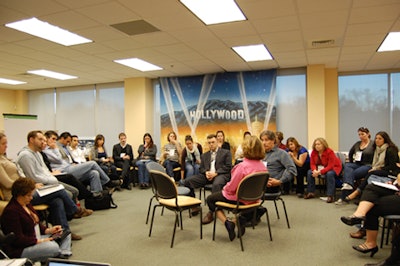
EventCamp East Coast, the regional conference for event and meeting professionals, took place in Plymouth Meeting, Pennsylvania, near Philadelphia, on Friday and Saturday. Nearly 40 event and meeting professionals gathered for relatively informal networking and discussions. Facilitated by Adrian Segar and following his peer-conference-style model, the two-day event provided insight into the growing"unconference" movement, as well as attendees' current concerns. Here are five interesting ideas discussed and implemented during the gathering:
1. Fishbowl-style formats can increase participation in large group discussions.
To wrap up EventCamp and allow the attendees to debate the future of their online Twitter community (which operates under the #eventprofs hashtag, Segar used a fishbowl-style format. With all participants seated in a circular configuration, five chairs in the center formed an inner circle and served as the speaker area for the discussion. Only those seated in the inner area could speak, but anyone in the outer circle could voice their opinions by moving into any empty chair in the inner circle. The advantage of this style is that it gives all members of the audience an opportunity to participate without having too many people talking over one another.
2. The environment—including sound, room temperature, and smells—plays a role in the attentiveness and productivity of attendees.
Andrea Sullivan, founder of BrainStrength Systems, a company that looks to identify brain-compatible strategies for improving productivity and attentiveness, led a discussion titled "Brain-Friendly Ways to Keep Attendees Engaged." During the seminar, Sullivan pointed out that small environmental elements can adversely affect how much information event and conference guests absorb. For instance, an optimal temperature range is between 68 and 72 degrees, and certain foods, such as yogurt, can stimulate brain activity.
3. Badge design can be an important element to networking.
Segar based the design of the badges for EventCamp East Coast on some recent research, looking specifically at how style, layout, how they're attached, and even font size can play a role in badges' effectiveness. Segar argued that a name tag should not only be useful for the person wearing it, but also for other attendees who want to identify colleagues and people to network with. Thus, EventCamp's pieces measured four and a half inches by six and a half inches, with names in large type and information about the schedule on the back.
4. With social media strategies, identifying where your audience is most active is as important as the tool you use.
Social media was a topic most attendees of EventCamp wanted to discuss, from how to encourage late adopters of the technology to use it to what to do with the data collected in the long term. One aspect broached was the P.O.S.T. methodology, an acronym used to identify the people (the target audience of an event, promotion, meeting, or conference and the social media platform where they are most active), objectives (what action the strategy is looking to achieve), strategies (the end result expected), and technologies (the tools through which the goals for the other steps can be met). The concept stresses that the most successful strategies assess where a primary audience is located first, before tactics and goals are decided upon.
5. Livestreaming can enhance some events, but may not work for some unconference models.
With much talk centered around Twitter, Web-based and mobile technology, and virtual meetings, EventCamp raised questions about which conferences and events would be appropriate for livestreaming. While some attendees stressed the importance of being anonymous and how some of the interaction wouldn't translate, others wanted to bring in thoughts from outsiders. To Samuel J. Smith, managing director of Interactive Meeting Technology, who helped organize and broadcast EventCamp Twin Cities in September, the East Coast gathering wasn't the type of event format that lent itself to Webcasting. "A video stream here would have failed—badly," he said. "It would have been like watching the Ann Arbor City Council on public access television; people would have left after three minutes. Then, they would have complained that the livestream was no good."



















